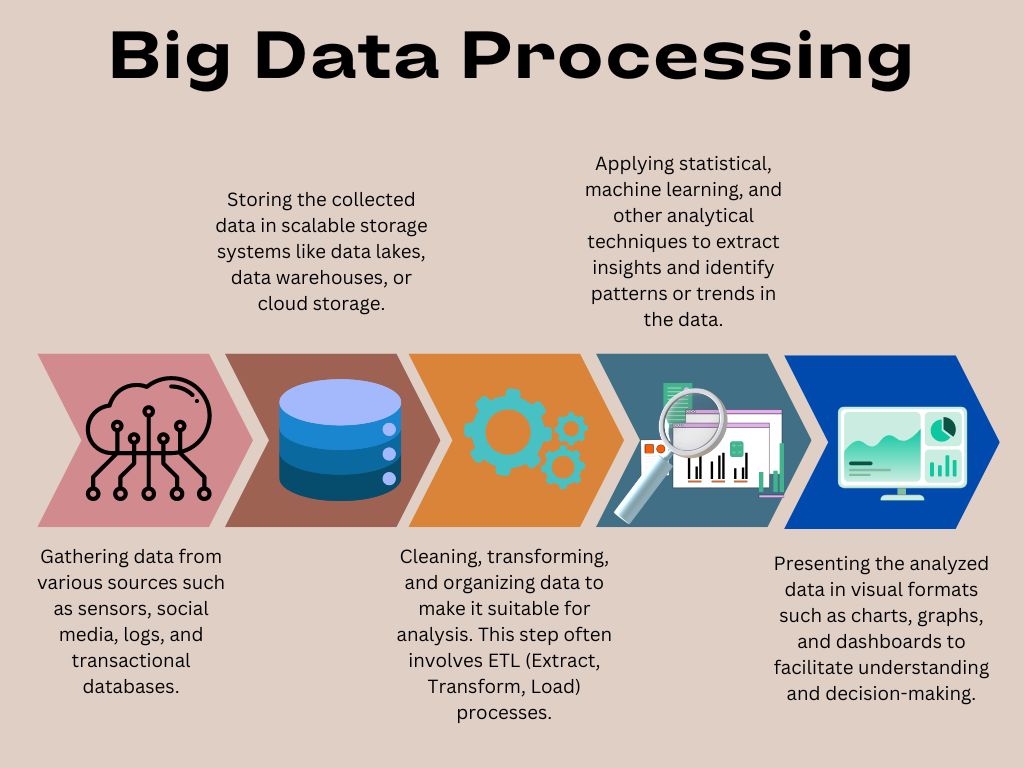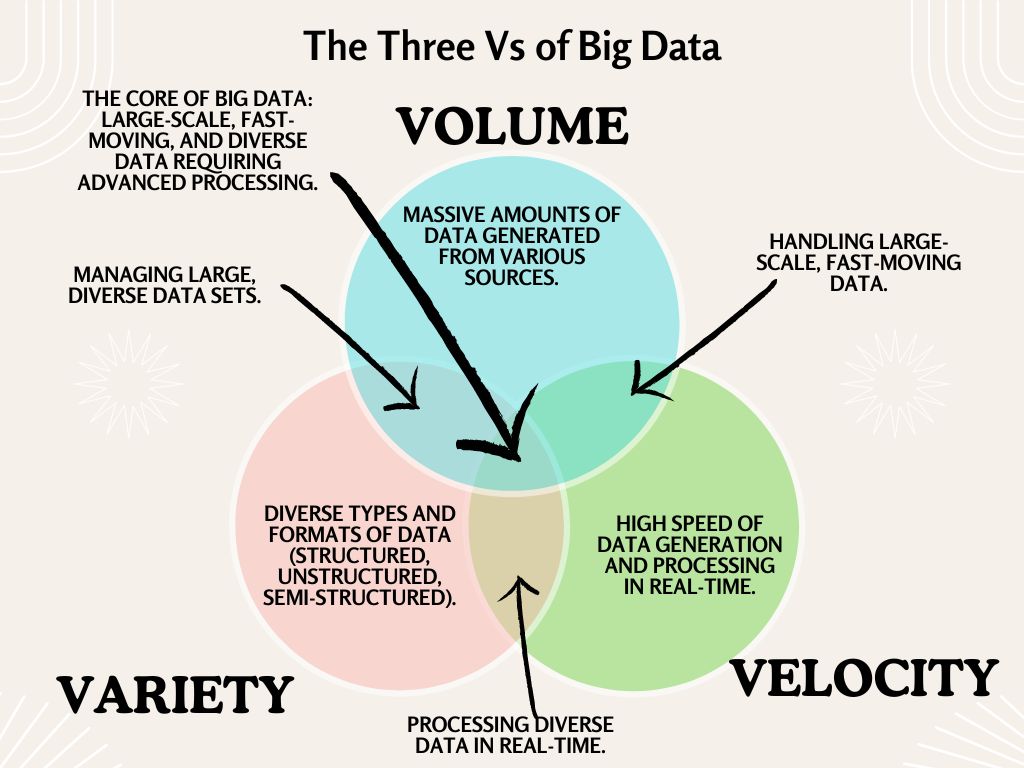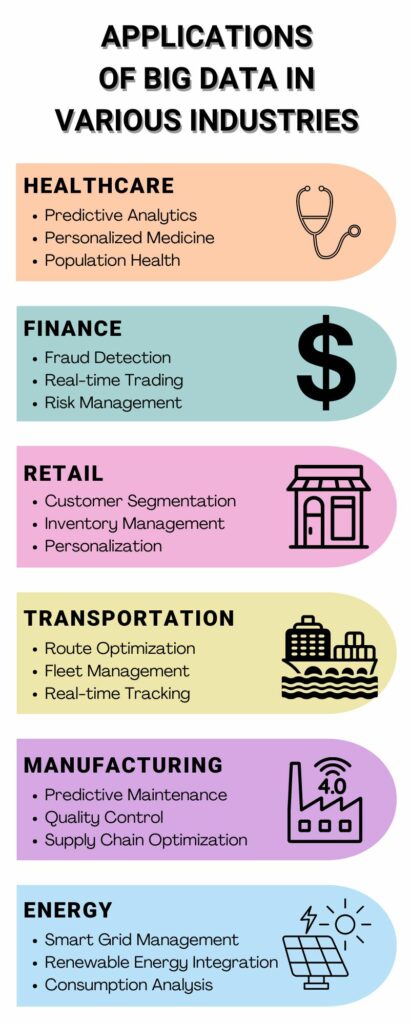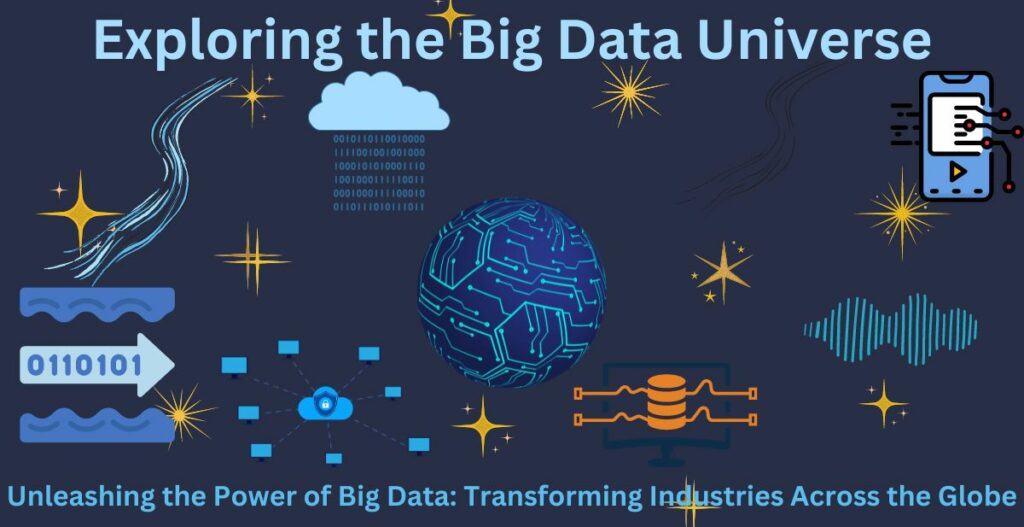In today’s digital age, the sheer volume of data generated every second is staggering. The data transformation process is becoming critical as industries adapt to this influx, revolutionizing how they operate and make decisions. Social media interactions and sensor data from smart devices flood the world, offering abundant information ready for harnessing. This data revolution drives unprecedented data transformation across various industries, reshaping how businesses operate and make decisions https://www.amazon.com/Big-Data-Practice-Successful-Extraordinary/dp/1119231388. Big data isn’t just a buzzword; it’s a transformative force driving innovation across various sectors. Data analytics is transforming healthcare, finance, retail, and entertainment industries. For insights into AI’s role in healthcare data management, enhancing patient care and operational efficiency, explore our detailed article. They use it to gain insights, boost efficiency, and create personalized experiences. With advancements in data transformation techniques, businesses can now handle vast amounts of information more efficiently.
This blog delves into the fascinating universe of big data, exploring its origins, the technological advancements powering its growth, and the myriad ways it is reshaping industries globally. Join us as we uncover how the Data Revolution is becoming the cornerstone of modern business success and shaping the data analytics future across industries.
Introduction to Big Data and the Data Revolution
The Significance of the Data Revolution
People generate over 2.5 quintillion bytes of data daily in today’s hyper-connected world https://www.amazon.com/Big-data-innovation-competition-productivity/dp/0983179697. For engineers, this means unlocking precise problem-solving and innovative designs. For business leaders, it means making strategic decisions that drive competitive advantage. But how exactly can we harness this vast ocean of data to drive future innovations and strategies? Big data relies on robust data transformation practices to ensure that raw information becomes actionable insight for innovation. Using advanced data transformation techniques helps industries extract actionable insights from raw data at scale.
The Data Revolution’s Impact on Engineering and Business
Advancements in computer power and storage technologies have allowed us to process large datasets quickly, supporting the adoption of data-driven strategies that transform corporate decision-making and engineering solutions. This data revolution transforms everything, including strategic corporate decision-making and engineering problem-solving. The internet-fueled global connectedness is changing communication and impacting many different fields. Sophisticated data processing and analytics are essential for deriving valuable insights from various industries.
How the Data Revolution Impacts Decision-Making and Innovation
The strategic use of data drives progress in society, from business to healthcare, ushering in a period of well-informed decision-making that fosters innovation and advances society https://ideas.repec.org/a/eee/jbrese/v70y2017icp356-365.html.
We define big data as massive information volumes surpassing traditional processing capabilities. Three key attributes characterize big data: volume (scale of data), velocity (speed of data generation), and variety (diverse data formats) http://Gandomi, Amir, and Murtaza Haider. “Beyond the hype: Big data concepts, methods, and analytics.” International Journal of Information Management, vol. 35, no. 2, 2015, pp. 137-144. Big data comprises either organized (or structured data) or unorganized (or unstructured data). We need a different processing set to accommodate the handling and use of big data, which relies on advanced computing, storage, and data processing.
Businesses across industries apply big data processing to decision-making, innovation, and optimization. Decision-making can be far more data-driven than relying on intuition and improve the accuracy of strategic choices. Uncovering patterns, trends, and behaviors aids innovation, leading to the development of new products and services. Optimization is already data-driven; therefore, much larger data sets will improve it, further improving efficiency, resource allocation, and overall performance.
Big data enables businesses to develop a data-driven strategy that supports accurate, timely decision-making and fosters ongoing innovation. Learn how data science drives business success by effectively leveraging big data for strategic results.
Unlocking Opportunities: How the Data Revolution Shapes Big Data Applications
Big data introduces the ability to process larger data sets that improve the areas already dependent on data: predictive analytics, risk management, scientific discoveries, and personalization services. Predictive analytics is an existing field that utilizes data to anticipate future trends, market shifts, and potential challenges. Risk management utilizes data to identify and mitigate potential risks proactively and will benefit from larger data sets in terms of greater accuracy and more scenarios. Research uses datasets to validate hypotheses and uncover information to make discoveries. Large data sets will greatly research, especially in the area of medicine. Personalization services rely on customer data, and the ability to rapidly process larger datasets of customer data will enable better product and service tailoring based on individual preferences and behaviors. Predictive analytics relies heavily on sophisticated data transformation techniques to anticipate trends and address challenges effectively.
This blog article will elaborate on the concepts around big data and provide several real-world examples along with the significance of big data.

Fundamental Concepts of the Data Revolution
Defining Big Data: Volume, Velocity, and Variety
Big data’s characteristics are based on volume, velocity, and variety. However, traditional data processing technology’s capacity cannot match big data in each of these three dimensions. Data transformation practices prepare and structure big data for effective processing and analysis, meeting the demands of volume, velocity, and variety. The exponential growth of data production, alongside the advancements in computing and communication technology, contributes to the data revolution.
Volume is the most obvious characteristic, and data production has grown exponentially along with the exponential growth of computing and communication technology. Effective data transformation techniques are crucial to manage and utilize this vast volume. Also, the speed has increased with the generation and collection of data and the need for this data to be processed in real-time. Variety also needs to be considered because traditional data processing has handled data only in one format. However, big data is generated by different data sources, each producing data in different formats and often unstructured that cannot be handled by traditional data processing techniques.

New Processing Technologies Powering the Data Revolution
Given the immense amount of data generated that needs to be processed, new ways of organizing and managing this data are necessary than the traditional data sets of the past. Different approaches to analyzing this data are essential where the emphasis is on patterns, trends, and correlations, therefore making better-informed decisions. To understand the technological advancements powering big data processing, explore our in-depth discussion on big data infrastructure.
For a deeper dive into how advanced machine learning frameworks like TensorFlow can handle massive datasets efficiently, explore our guides:
- What is TensorFlow? Exploring Its Impact on Big Data and AI
- Supercharge Your Big Data Projects with Advanced TensorFlow Techniques
Demands are also placed upon the infrastructure that needs to be scalable in terms of storage, processing, and retrieval of data. For organizations leveraging Apache Spark for big data processing, optimizing Spark performance is essential to achieve scalable and efficient workflows. Explore our comprehensive guide on optimizing Spark performance and speed for practical tips on enhancing Spark’s capabilities for large-scale data projects. Finally data quality needs to be assured in terms of both its accuracy and relevancy in supporting informed decisions. Advanced data transformation techniques are essential for organizing and analyzing vast data sets, helping businesses uncover patterns and correlations that drive strategic innovation.
The Importance of Data Quality and Infrastructure
The speed at which data is produced is also exponentially increasing given that intelligent devices have become prolific and this data needs to be processed in real time for timely insights, especially in an industrial process. Not only is the speed at which data is produced but data also changes rapidly and can become outdated very quickly, therefore it must be processed and evaluated before becoming obsolete. The other factor is that the necessary response to changing data is also time-limited and the data processing systems need to ensure that data is processed promptly allowing timely action on that data. Data transformation techniques play a pivotal role in ensuring data quality and preparing data for real-time insights, especially in industries relying on timely decisions.
The diversity of data challenges traditional data processing systems designed to handle only one type of data structure where data now is generated from diverse sources with their structure and often data is either only semi-structured or unstructured. It is necessary to integrate information from different sources and formats and build tools and methodologies to enable this and take a holistic approach to the information landscape.
Volume, Velocity, and Variety are the three Vs that drive the choices in tools and methodologies for building big data processing systems needed to unlock the full potential of big data.
Real-world Examples
Numerous real-world examples benefit from the application of big data, illustrating the profound impact of the data revolution across various sectors, including healthcare, finance, retail, transportation and logistics, manufacturing, and energy.
Healthcare: Predictive and Preventative Analytics
Big data analytics applies to patient data, genetic information, medical histories, treatment outcomes, and population-health level data. This enables the prediction and prevention of diseases, tailoring treatments to individual patients and targeted interventions to improve public health. Real-time insights and evidence-based recommendations will support better clinical decision-making. In healthcare, data transformation techniques allow for seamless patient data integration to improve predictive analytics.
Finance: Predictive and Preventative Analytics
Institutions produce financial data in vast amounts in real-time, revealing identifiable patterns that assist in making real-time trading decisions and help assess and mitigate various types of risk through advanced modeling and predictive analysis. Likewise, transaction data contains identifiable patterns and anomalies exposing fraudulent and illegal activities and regulatory violations. Financial institutions are also able to derive marketing intelligence from the same data.
Retail: Personalization and Inventory Optimization
Data sources in the retail sector include customer data, sales data, supply chain information, and market trends. Analysis of such data enables the segmentation of shoppers and personalization based on preferences, purchasing behavior, and demographics. Both inventory and pricing optimization can result in a more efficient operation. Tracking and analyzing supply chain activities will result in more advanced management, often the Achilles heel of business operations. Data transformation techniques are essential for integrating diverse retail data sources, enabling accurate customer segmentation and inventory management.
Transportation and logistics: Fleet Management and Route Optimization
There is a multitude of data sources for transportation and logistics ranging from vehicles, elements of the supply chain including source and destination, the environment including weather and traffic to the demand for transportation services. Benefits from the application of big data tools and processes include better fleet management of vehicles, superior route optimization, real-time demand forecasting, better real-time tracking and visibility, and superior delivery to customers.
Manufacturing: Quality Control and Predictive Maintenance
Building on the earlier examples, big data in manufacturing optimizes production processes and the supply chain (such as inventory management and just-in-time manufacturing) by using sensor data from machines, quality control data, and other sources. This allows for enhanced quality control, fault identification, and mass customization that is individualized and predictive maintenance that optimizes product design. Manufacturers may increase their efficiency by using big data to optimize processes and manage energy.
Energy: Grid Management and Renewable Integration
Analyzing data from instrumentation across the entire energy supply chain will benefit energy production and consumption. This includes data from production to consumption and environmental data. An important growing field is energy integration from different energy sources, including renewable energy. Big data analytics is already playing an essential role in this field. Other key benefits include grid management, demand response optimization, and energy efficiency programs.

Other examples
Examples are plenteous of the application of big data and far too numerous to be mentioned here but several include:
- Telecommunications: Enhancing Connectivity
- Agriculture: Data-driven Farming
- Smart Cities: Urban Optimization
- Social Media: Analyzing Trends and Behaviors
The Significance of the Big Data Revolution
Data-driven Decision Making
Society is becoming increasingly data-driven due to the unstoppable progress of digital technology. The generation and processing of data are exponentially increasing. This data revolution has transformed industries, where insights into consumer behavior, market trends, and societal patterns are increasingly obtainable. Decision-making processes are becoming more data-driven, eliciting greater efficiency and innovation in many organizations. Both government and non-government can address societal challenges more effectively. As organizations continue to adopt data-driven approaches, the data analytics future promises even greater advancements in efficiency and innovation.
Big data is key in informed decision-making and predictive analysis across many industries and sectors. Building a foundation for evidence-based decision-making, whereas predictive analysis utilizes historical data to forecast future trends and outcomes accurately. It also identifies potential threats and opportunities in advance, enhancing risk management and taking proactive measures. Big data also allows for predictive modeling and optimization, improving resource allocation and efficiency. Data-driven decision-making in modern industries often depends on sophisticated data transformation techniques to convert raw data into actionable insights.
How the Data Revolution Fuels Competitive Edge and Market Dynamics
Organizations can gain a competitive edge by leveraging big data for data-driven strategies that enhance understanding of market dynamics and consumer preferences. This also applies to real-time monitoring and response to market changes, extending an edge over competitors. Data-driven decision-making facilitates agile decision-making processes that enable quick adaptation to changing business landscapes. Better processing of consumer data improves personalization, improving consumer satisfaction and loyalty.
Privacy, Security, and Ethics in the Data Revolution
The other key considerations of big data are the implications for privacy, security, and ethical concerns https://www.researchgate.net/publication/268630317_Big_Data_ethics. Delve into the challenges and opportunities presented by big data, including privacy and security concerns, in our comprehensive overview. Big data can easily contain sensitive personal information that is often vulnerable to data breaches and cyber-attacks. This data is also at risk of being misused by organizations holding that data. Facebook selling personal data to Cambridge Analytics is a case in point. There are increasing calls for improved governance across organizations and governments. Data handling practices need to have transparency and accountability.

Future Trends of the Data Revolution and Conclusion
Looking ahead, the data analytics future is intertwined with emerging technologies such as AI and edge computing, paving the way for innovative data management and analysis approaches. As the data revolution advances, robust data transformation techniques will continue to be essential for unlocking deeper insights and driving innovation. Stay informed about the latest transformative trends in big data, shaping the future of technology.
The Synergy with Artificial Intelligence
The impact of big data on society will only continue to increase. This is due to its progress and its synthesis with other emerging technologies. Therefore, guidelines for its proper use are becoming more urgent. Emerging technologies combined with big data include artificial intelligence, edge computing, and blockchains.
Artificial intelligence complements big data. Big data generates and organizes large datasets, and artificial intelligence derives meaningful information from those datasets. Areas where artificial intelligence can enhance big data include predictive analytics, automated decision-making, and improved personalized experiences through AI-driven insights. Also, the analysis of unstructured data is greatly enhanced by recent advances in natural language processing, driving the big data revolution. Combining AI with data transformation techniques enables faster, more accurate data processing and insights.
Advancements in Edge Computing
Continual advances in digital technology are enabling devices to perform big data processing, advancing the field of edge computing. Local data processing of these devices promises to reduce bandwidth, in turn reducing costs and latency while improving security. This will improve scalability for IoT and sensor networks. Also support for offline operations where environments are remote or disconnected.
Blockchain Integration for Data Security
The benefits of blockchain integration are increased data security and integrity through decentralized storage. Given that data records are immutable and decentralized it benefits activities between multiple parties when trust and compliance are needed. The two main examples are financial transactions and supply chain management. The other key benefit is that data transactions are transparent and traceable.
The Need for Data Governance and Ethical Compliance
Finally, data governance and compliance along with ethical considerations will take on greater urgency for big data. Focus on data privacy and consent will become heightened especially with the advances in AI and data ownership. Compliance and transparency frameworks will need to be developed along with the necessary legal frameworks to enforce compliance.



